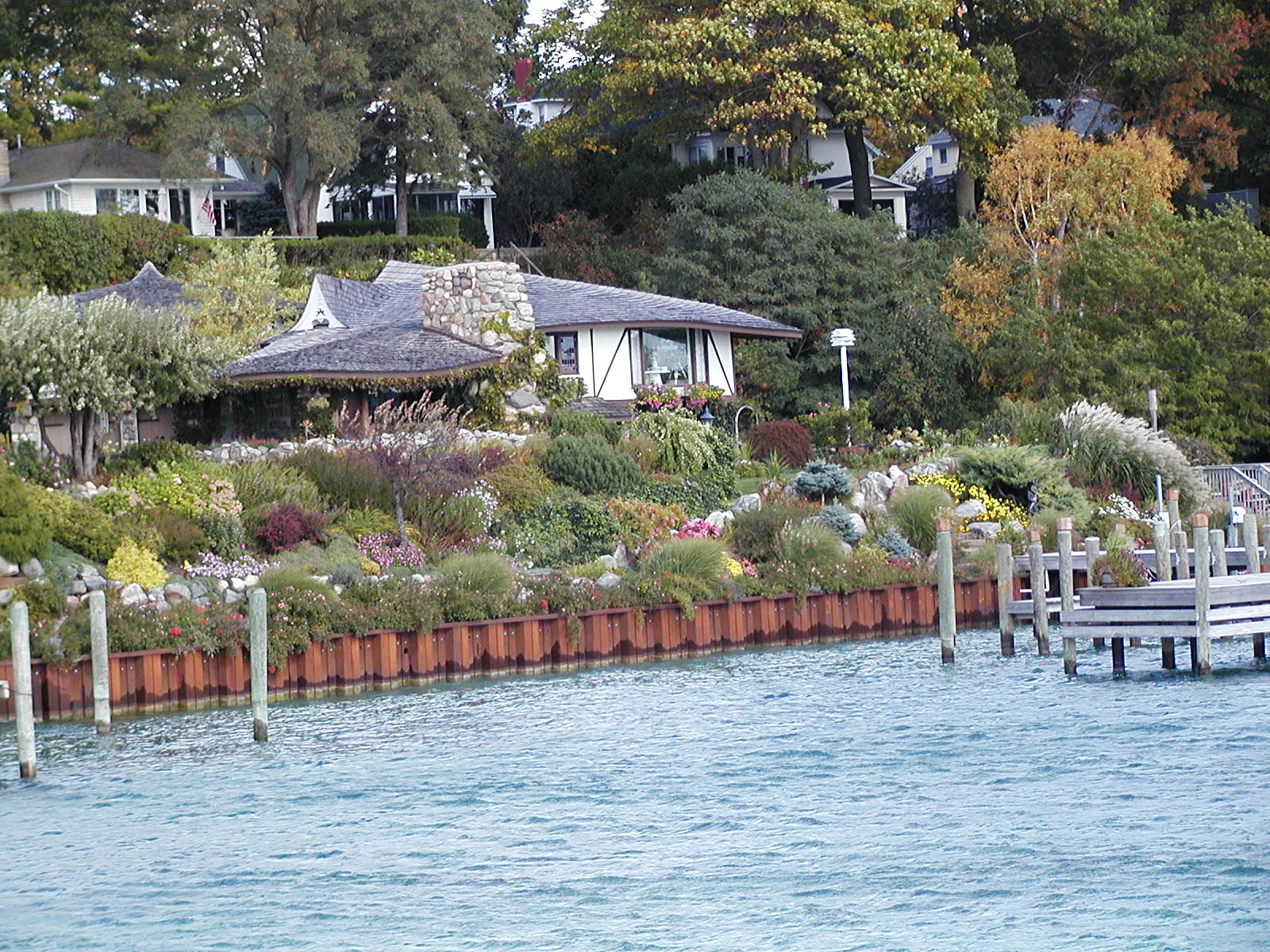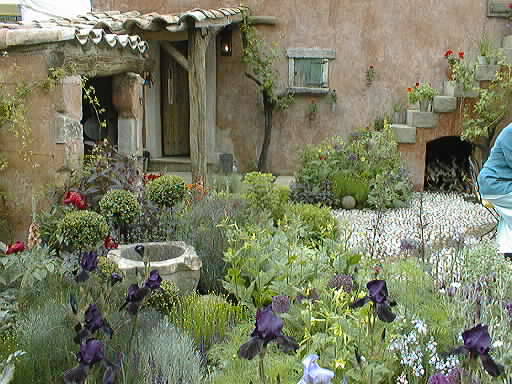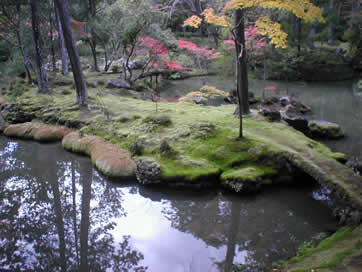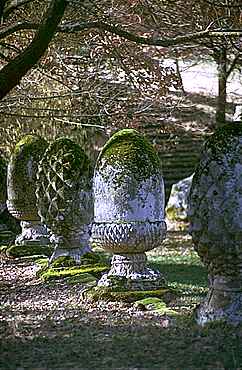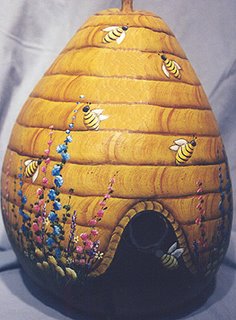Monday, December 18, 2006
housekeeping
Anyway, this morning I linked to a great resource for "how to talk to global climate change skeptics", and thought to myself, this is off topic, and I reallly need to get back to my garden blogging roots.
Time for a New Year's Resolution... My garden blog will soon be reverted to gardening and my ecological concerns will be posted on my new garden politics blog..."migreenroof". The link can be found over there on the right where it says "view my complete profile." Click on that link and the list of some related blogs (no not all of the above), including the new Michigan Green Roof blog, will appear.
Herbies might be interested in The Backyard Herbalist blog. It's a public portal for a Yahoo Group for the MSU Extension Herb Garden project. You don't have to be a Master Gardener or a Herb Society member to volunteer there, it is a demonstration herb garden for the community. Just contact me and we'll talk about it.
Tuesday, December 12, 2006
For GCHS members...
(FYI: You'll need an account with Yahoo, but it's EASY, and FREE to sign up. You just make up a "screen name" and a private password)
Click here to join gcherbs
Sunday, December 03, 2006
Planting a Sequoia
All afternoon my brothers and I have worked in the orchard,
Digging this hole, laying you into it, carefully packing the soil.
Rain blackened the horizon, but cold winds kept it over the Pacific,
And the sky above us stayed the dull gray
Of an old year coming to an end.
In Sicily a father plants a tree to celebrate his first son’s birth--
An olive or a fig tree--a sign that the earth has one more life to bear.
I would have done the same, proudly laying new stock into my father’s orchard,
A green sapling rising among the twisted apple boughs,
A promise of new fruit in other autumns.
But today we kneel in the cold planting you, our native giant,
Defying the practical custom of our fathers,
Wrapping in your roots a lock of hair, a piece of an infant’s birth cord,
All that remains above earth of a first-born son,
A few stray atoms brought back to the elements.
We will give you what we can — our labor and our soil,
Water drawn from the earth when the skies fail,
Nights scented with the ocean fog, days softened by the circuit of bees.
We plant you in the corner of the grove, bathed in western light,
A slender shoot against the sunset.
And when our family is no more, all of his unborn brothers dead,
Every niece and nephew scattered, the house torn down,
His mother’s beauty ashes in the air,
I want you to stand among strangers, all young and emphemeral to you,
Silently keeping the secret of your birth.
Thursday, November 30, 2006
sharing
Wednesday, November 29, 2006
a model
Monday, October 30, 2006
a peaceful scene
Monday, October 16, 2006
Tuesday, October 03, 2006
busy busy busy - more about rose hips
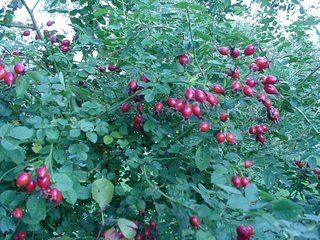
Out gathering more rose hips, these from the R. englatine (the one whose foliage smells like fresh green apples)and cleaning and drying them in the dehydrator for tea.
I clean them by cutting off the ends and scooping out the middle- seeds, furzy stuff, and once in a while a leetle white worm. Then pop the hips in the dehydrator.
Good for you.
Did I tell you my German-American friend, Ulrike's story about growing up poor in wartime Germany. The kids would pick rosehips on the way to school to eat, and scrape the furzy stuff in the middle out to use as "itching powder" to tease the other kids... Kids will be kids. I seem to remember reading that during the same war English kids were fed rosehips as well, both sides' children were sorely lacking good sources of Vitamin C, such as citrus fruit, and rose hips being the very best source of C and its accompanying bioflavinoids.
Check the C bottles next time you go past the Vitamin counter at the store, they still add rose hips to better brands.

Friday, September 29, 2006
Autumn Song

The firelight glows,
The embers sigh,
We dream and
Doze--
The cat and I.
The kitten purrs,
The kettle sings,
The heart remembers
Little things.
The 'little thing' in the photo is a clearwing or hummingbird moth, visiting the flowers of a butterfly bush. Thanks for sending me the photo, Bonnie.
Monday, September 18, 2006
containers
This is a balcony in Rome.
If you post it for everyone to see, you might find it on someone's blog, Bubbie.
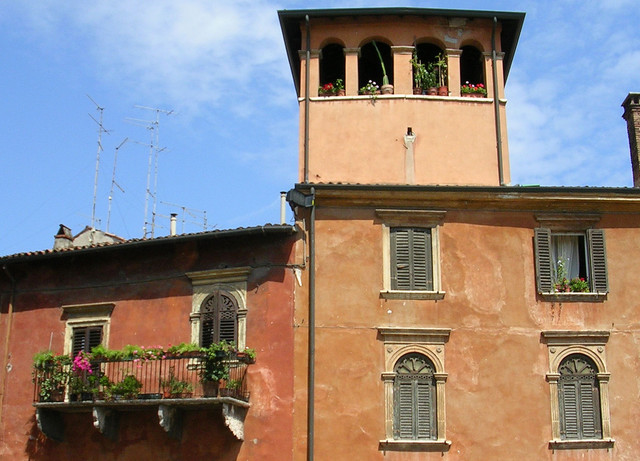
Thursday, September 14, 2006
The Herb Gatherer
From Collected Poems, 1914-1948
When fragrant fires of autumn smoulder
By upland pastures for wind to blow
And grain shocks stand, row after row,
He throws a sack across his shoulder
And trudges away in the mellow glow
To gather herbs – though he is older
Than most of the old men I know.
He squints in the sun, and always follows
The spring brook where the calamus hides
And he nibbles it, and away he strides
For thyme and tansy in sunny hollows,
Then on to burdock. His faith abides
in it for bitters, in careful swallows,
When winter had chilled his old insides.
Sage and boneset – his eyes keep sighting
Out of profusion the things he would find.
Pennyroyal, horse mint – these he will bind
In neat little bundles, always righting
Some slight disorder . . . at least in his mind.
He will hang them on rafters, ready for fighting
The ills of age . . . with the years so kind!
His old cheeks flush with the autumn weather.
His old eyes shine when the quail wings sound.
A sack that smells of the air and the ground
With tang and mellowness there together
Over his shoulder! And all around
The breath of autumn! . . . I wonder whether
Gathering helps more than the herbs he found.
Wednesday, September 13, 2006
so gather your rosebuds, too, girls
by Robert Herrick
GATHER ye rosebuds while ye may,
Old time is still a-flying:
And this same flower that smiles to-day
To-morrow will be dying.
The glorious lamp of heaven, the sun,
The higher he's a-getting,
The sooner will his race be run,
And nearer he's to setting.
That age is best which is the first,
When youth and blood are warmer;
But being spent, the worse, and worst
Times still succeed the former.
Then be not coy, but use your time,
And while ye may go marry:
For having lost but once your prime
You may for ever tarry.
This poem played a role in Dead Poets Society when Robin Williams used it to inspire his students, thus...
"They're not that different from you, are they? Same haircuts. Full of hormones, just like you. Invincible, just like you feel. The world is their oyster.
They believe they're destined for great things, just like many of you, their eyes are full of hope, just like you.
Did they wait until it was too late to make from their lives even one iota of what they were capable?
Because, you see gentlemen, these boys are now fertilizing daffodils.
But if you listen real close, you can hear them whisper their legacy to you.
Go on, lean in. Listen, you hear it?
Carpe ... hear it?
Carpe ... carpe diem, seize the day boys, make your lives extraordinary. "
Tuesday, September 12, 2006
gather your roseHIPS while ye may... and make jam
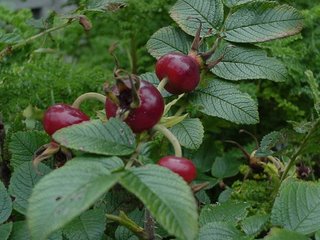 I know, it's rosebuds in the poem, and the common wisdom says gather rosehips after the first frost. (It supposedly kills any harboring insects.) But I like to pick them in the beginning of autumn, but before the frost hits, when they are ripened but still firm, like an apple. If you wait for the weather to turn you'll lose alot of them to drying up, mushiness, those little 'worms' will grow and ruin the fruit, and so on.
I know, it's rosebuds in the poem, and the common wisdom says gather rosehips after the first frost. (It supposedly kills any harboring insects.) But I like to pick them in the beginning of autumn, but before the frost hits, when they are ripened but still firm, like an apple. If you wait for the weather to turn you'll lose alot of them to drying up, mushiness, those little 'worms' will grow and ruin the fruit, and so on.So I say, pick them NOW, and make jam...
Here's my Rosehip Jam recipe.
Pick some rosehips. I pick about a colander full. So you know right now, this recipe is not precise, but it works. Some say the big apple-y R. rugosa type are the best. They are big and pretty, and look like little apples... see the photo.
But this year I liked the hips from my R. glauca because it is so prolific and the hips are nice and clean of insects. Because I grow without chemicals, the R. rugosa has some little worms in many of the hips this year. Hey, I never promised you a rose garden. But the photo is pretty, isn't it.
Next, wash the hips, cut them all in half, then go through and clean out the seeds and little odd bits. Soak the cleaned hips in water (enough to cover) in the pot you will cook them in, for several hours, which will soften them.
Then when you are ready to make jam, bring the pot to a boil, and boil for 15 minutes, uncovered.
Strain the boiled water/juice into a large measuring cup. In this case I got 1 1/2 cups. Set the fruit aside, and add an equal measure of sugar (in this case, 1 1/2 cups sugar) to the liquid, and stir to dissolve it.
Boil the sugared water/juice until it thickens, stirring constantly.
Add the fruit and cook, stirring, until it is a nice jammy consistency.
Be careful not to burn it.
Your rosehip jam will be beautiful, it looks a bit like cherry jam.
Pour into clean jars and cap. Label, Store in the fridge.
In this case I got three jelly jars, filled. Here's a picture:
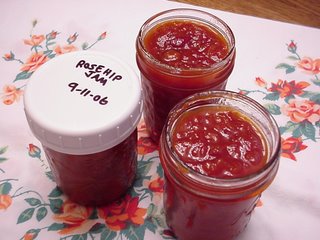
Sunday, September 10, 2006
Saturday, September 09, 2006
Friday, September 01, 2006
Thursday, August 31, 2006
Tuesday, August 29, 2006
Sunday, August 27, 2006
Friday, August 18, 2006
Tuesday, August 15, 2006
Thursday, July 06, 2006
summer/vacation/path/poem

If You Get There Before I Do
Air out the linens, unlatch the shutters on the eastern side,
and maybe find that deck of Bicycle cards
lost near the sofa. Or maybe walk around
and look out the back windows first.
I hear the view's magnificent: old silent pines
leading down to the lakeside, layer upon layer
of magnificent light. Should you be hungry,
I'm sorry but there's no Chinese takeout,
only a General Store. You passed it coming in,
but you probably didn't notice its one weary gas pump
along with all those Esso cans from decades ago.
If you're somewhat confused, think Vermont,
that state where people are folded into the mountains
like berries in batter. . . . What I'd like when I get there
is a few hundred years to sit around and concentrate
on one thing at a time. I'd start with radiators
and work my way up to Meister Eckhart,
or why do so few people turn their lives around, so many
take small steps into what they never do,
the first weeks, the first lessons,
until they choose something other,
beginning and beginning their lives,
so never knowing what it's like to risk
last minute failure. . . .I'd save blue for last. Klein blue,
or the blue of Crater Lake on an early June morning.
That would take decades. . . .Don't forget
to sway the fence gate back and forth a few times
just for its creaky sound. When you swing in the tire swing
make sure your socks are off. You've forgotten, I expect,
the feeling of feet brushing the tops of sunflowers:
In Vermont, I once met a ski bum on a summer break
who had followed the snows for seven years and planned
on at least seven more. We're here for the enjoyment of it, he said,
to salaam into joy. . . .I expect you'll find
Bibles scattered everywhere, or Talmuds, or Qur'ans,
as well as little snippets of gospel music, chants,
old Advent calendars with their paper doors still open.
You might pay them some heed. Don't be alarmed
when what's familiar starts fading, as gradually
you lose your bearings,
your body seems to turn opaque and then transparent,
until finally it's invisible--what old age rehearses us for
and vacations in the limbo of the Middle West.
Take it easy, take it slow. When you think I'm on my way,
the long middle passage done,
fill the pantry with cereal, curry, and blue and white boxes of macaroni, place the
checkerboard set, or chess if you insist,
out on the flat-topped stump beneath the porch's shadow,
pour some lemonade into the tallest glass you can find in the cupboard,
then drum your fingers, practice lifting your eyebrows,
until you tell them all--the skeptics, the bigots, blind neighbors,
those damn-with-faint-praise critics on their hobbyhorses--
that I'm allowed,
and if there's a place for me that love has kept protected,
I'll be coming, I'll be coming too.
From The Day Before by Dick Allen, published by Sarabande Books, Inc. Copyright © 2003 by Dick Allen.
Friday, June 30, 2006
Borage diary

2001: My borage always self-sows, so I was watching for it this spring (which BTW was cold and WET) but I thought, when it didn't appear, that it was not coming back. However, it did start to sprout seedlings in mid-July, which was droughty and hot, and is doing nicely once more in a terrible droughty and record-setting hot August.
September 2001: it is doing beautifully.
Disappeared 2002.
Planted 2003.
May 30, 2006: My borage volunteers started blooming yesterday, tasted one last night.
I am an obsessive weeder. I think the years that I lose my borage are the same as the years when I get around to all my weeding early.

I've dedicated two spots to borage - one in the back of the herb garden where it can go nuts - an eastern exposure. And the second in and around the cold frame, near the back door, to pick for topping salads, when I pick lettuce.
Borage is for cheerfulness and courage. Here's something interesting I've read, that i'm going to try: the leaves contain the same chemical as the saltpeter that is added to incense to help it burn. You can burn the dried leaves and they will throw off sparks. Mother Nature's Fireworks? Sounds like fun!
Thursday, June 29, 2006
a few more lavender photos
Here are a few more lavender photos, a 'Provence' and my 'Jean Davis.' In case you don't know, you can click on the photo and get a better size for your viewing. At least on my 'puter I do.
I already harvested the nicest stems from these plants, and as you can see, the 'Provence' has passed picking stage. Lavender should be picked before the flowers open... I wait to see a few lower flowers open, and get picking then.
All that is left on the 'Jean Davis' are the smaller flower heads, so I'll just leave both of these plants alone, to be "landscape" features, with an occasional raid for culinary purposes or little bouquets.


Wednesday, June 28, 2006
garden humor, Irises and cottonwoods

The photo was taken on our short vacation trek to Traverse City, we caught the Iris Farm on a good day. Serendipity. It was lovely, I ordered irises to be dug and sent at the proper time, and there were artists working everywhere.
Anyway, here's the garden humor...
Albuquerque had a fascinating ordinance passed recently that followed along the same lines of one passed in Tucson a number of years ago. They have banned the planting and sale of five plant genera because of their pollen: Cupressis; Ulmus; Morus; Populus; and Juniperus. The last two seem most amazing, what with the quaking aspen groves in the mountains, the cottonwoods in the desert watering holes, and the millions of Juniperus monosperma in the desert surrounding Albuquerque.
On the horticultural tour, noticing several elm seedlings near a commercial planting, a Kansas agent quipped, "Look out - organized crime."
Ba da bum.
Actually, to me, Cottonwood trees are noxious weeds. If I was Queen of the World, there would be a law against them.
Early June is the time for inviting folks to your yard for tag sales, graduation parties, outdoor weddings... or even to enjoy the height of your yard's floral display, but my yard looks like it's been sitting right under a dryer vent.
Tuesday, June 27, 2006
Skunk recipe

Luckily, I haven't had to deal with skunk spray, but it's good to have the recipe for a remedy at hand:
Skunk odor neutralizer
(From Jenny Burrows)
1 quart 3% H2O2
1/2 cup baking soda
2 T. liquid soap
Spray, let sit 15 min., rinse.
The photo is from this link:
http://chrisinorl.home.att.net/home.html
Monday, June 26, 2006
In the Garden of My Life

Copied from a garden bulletin board about 5 years ago. If you know more about the source, let me know:
In the Garden of My Life
by Jeanne P. Maack
I ponder my existence in the garden of my life. I reflect upon the purpose for which I came to be. I commune with my Creator as I experience the wonders of His creation. The birds overhead surround me with their simple symphony. The bees buzz to and fro adding their voices to the birds' sweet melodies and suddenly there is a harmony of voices surpassed only by the choir of angels in the heavens above.
The flowers fill my garden with their colorful splendor and sweet fragrances. Even the rich black soil serves its purpose by providing a neutral background to all these gorgeous colors and shapes. The butterflies flit from flower to flower; their wings so colorful that the flowers seem jealous and at times pale in comparison.
The herbs add variety to a dull menu and the many varieties are so different just as humans are. No two flowers, no two plants, are exactly identical, similar but different as we are. I love to watch the wind rustle through my plants. They seem to dance to their own tune. The swing back and forth and sometimes even bow in honor of their Creator.
A popular little saying in the sixties told us to "take time to smell the roses"... a simple reminder to enjoy life; enjoy the beauty of nature around us. Another sixties slogan told us "bloom where you are planted"... reminding us to use what has been given to us and do our very best in the gardens of our lives. There is a harmony in nature that shows us how to live in peace and enjoy the simpler things in life.
My garden is a kaleidoscope of colors and textures, shapes and forms. Even the green stems and leaves are a multitude of hues and shades adding to its richness. If I had my way, I would sit for hours and hours just drinking in its beauty but alas, I only have a limited amount of free time to contemplate and meditate upon its rich diversity. It has been said that "one who plants is close to the heart of God".
We reap what we sow. If we sow love, we reap love. If we sow the seeds of neglect and apathy, we are alone and bitter. I am in awe that we simply take a dead seed and with proper nurturing give it new life which returns to us one hundred-fold. We cannot forget the sunshine in our garden which warms our earth and helps bring the seeds to life and helps them develop as they were meant to. We, too, need the "sunshine" of our family and friends to enrich our lives.
Take two minutes each day and go into your garden. Put all your troubles on hold. Use one minute to thank God for allowing us to experience the garden of our lives. Use the other minute to simply take it all in.

Friday, June 23, 2006
Lavender and roses
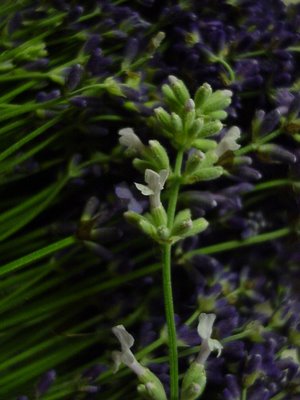
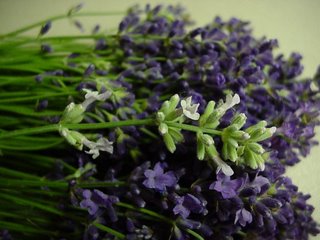
Everything is blooming its heart out this year. I wanted to try to photograph the subtle pastel pink of the 'Jean Davis' lavender, but can't seem to get it to show up in the picture. So I brought some indoors and put a sprig on top of a bundle of L. angustifolia. At least you can see the contrast.
And the roses are so loveable. I grow a dozen or so old garden roses, having had my fill long ago of the high maintenance ladies.
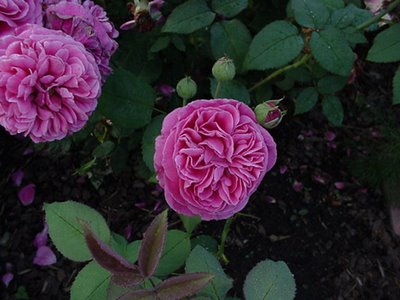

My rose list:
Rosa eglanteria (the eglantine rose)
r. rubra (or is it r. glauca?)
'The Fairy'
R. rugosa alba
R. rugosa rubra
R. canina (the dog rose)
'Konigen von Danemark'
'Madam Hardy'
'La Reine Victoria'
'Reine des Violettes'
'Mme Isaac Perriere'
R. gallica versicolor 'Rosa Mundi'
'Salet' (moss rose)
'Tuscany' (a gallica)
I like to bring favorites indoors to put on my bedside table and at the kitchen sink in small vases. Don't mind the dust... I've been in the garden!

Thursday, June 22, 2006
Recipe: Purple Lavender Punch

Breathe deeply. Put on a hat. Time to harvest the lavender.
This was a pretty good winter, not too wet. I grow lavender with varying degrees of success. The plants in my front yard do better than the plants in my herb garden, a testament to the "right plant in the right place" philosophy. In short form: the front yard is sunnier, and the plants are hybrids. The herb garden has it's own advantages for other herbs, but I have to admit, there is less sun there. And the plants were grown from seed: to save money I played the "vera" roulette. Angustifolias are the tastiest and sweetest smelling of the Lavandulas, in my opinion, but the hybrids in the front yard look impressive with their long stems and fat buds.
(The photo is from the state of Washington.)
Here is an unusual punch recipe. Most of the time, lavender punches rely on lemonade as a base. Of course, decorate pitcher with a little beribboned bundle of lavender sprigs.
LAVENDER PUNCH
1 cup water
1 cinnamon stick
1/2 tsp whole cloves
3 T fresh lavender flowers (OR 1 T dried lavender)
1 (6 oz.) can frozen limeade concentrate
2 cups Concord purple grape juice
1 lime, sliced
1 liter bottle club soda, seven-up, or ginger ale, chilled
In covered 1 quart saucepan, heat water, cinnamon, and cloves to boiling.
Simmer over low heat 5 minutes; remove from heat.
Add lavender flowers. Cover and let stand 10 minutes to steep.
Strain the brew into a bowl and discard the particles.
Stir frozen limeade concentrate into the brew until melted and add
grape juice. Cover and refrigerate.
Just before serving, pour into large pitcher.
Add lime slices and ice.
Tuesday, June 20, 2006
blessed to be boring
by Wendy Cope
"May you live in interesting times."
-ancient Chinese curse
If you ask me "What's new?", I have nothing to say
Except that the garden is growing.
I had a slight cold but it's better today.
I'm content with the way things are going.
Yes, he is the same as he usually is,
Still eating and sleeping and snoring.
I get on with my work. He gets on with his.
I know this is all very boring.
There was drama enough in my turbulent past:
Tears and passion—I've used up a tankful.
No news is good news, and long may it last,
If nothing much happens, I'm thankful.
A happier cabbage you never did see,
My vegetable spirits are soaring.
If you're after excitement, steer well clear of me.
I want to go on being boring.
I don't go to parties. Well, what are they for,
If you don't need to find a new lover?
You drink and you listen and drink a bit more
And you take the next day to recover.
Someone to stay home with was all my desire
And, now that I've found a safe mooring,
I've just one ambition in life: I aspire
To go on and on being boring.
Monday, June 19, 2006
Tina James does her thing

I don't claim to take good photos, but the 'Tina James' primrose is worth sharing...
It's an Oenothera, and the interesting part is that several blossoms will suddenly but predictably open every evening beginning in midsummer. June 17th began the show this year, although some volunteer seedlings I have transplanted to another location in the yard have been doing their thing for a few days already.

The third picture is of the blossoms after the show, you can see the light conditions have changed from twilight to dusk. She'll bloom all night for the night flying insect pollinators, and into the next day, but by the time noon rolls around the blossoms are drooping.

Friday, June 16, 2006
Thursday, June 15, 2006
Hummingbirds
(March 2002 From Liz on the Front Porch @ Yahoo)

Put a banana peel out to attract flies and other insect near feeders. Hummers need protein as well as nectar. Especially when they have young to feed. The rotting banana peel gives them a wonderful source of insects. I don't put all the peel out at one time. I cut it up into pieces which we keep in the freezer till a new one is needed.
Sounds gross but works.
Also do not take down any spider webs next to your feeders. The mommy hummers get tiny gnats for their young from the webs.
So far as attracting migrating hummers, use wide red ribbon on branches of trees near feeders. You can also put the ribbons on poles around the feeders. The fluttering of the ribbons helps attract them. Did not believe this till we tried it, wow, we got hummers. Had moved into this house and felt the hummers would not know where the feeders were. We put red ribbon streamers about 2 feet long from the branches of the pine tree. They found that one first. Also tied it to clothes line where one feeder was hanging, also the satellite dish. The next year we put out more feeders with the ribbon near the new feeder. The old hummers came to the unmarked feeders and new hummers came to the new feeders with ribbon. We have as many as 10-12 feeders on the half acre of land.
Some people use "surveyor's tape" available in hardware stores. Supposedly the hummers like ultraviolet light, which the tape reflects.
Check migration charts on hummingbirds. This can be done on:
www.hummingbird.net
This site also has interesting information on hummingbird moths.
My recommendation is not to buy nectar either in dry or wet form. It is so simple to make your own. There is no need to make the nectar red to attract hummers. DO NOT USE FOOD COLORING IN NECTAR!!! Also do not make the home made nectar strong than 1 part sugar to 4 parts water - it is not healthy for the hummers.
Another hint is not to put much nectar in each feeder. This will not waste as much and there will be less cleaning with the liquid not going as high into the feeder. We generally do not go through more than about 2 oz. per changing.
My personal favorite hummer feeder is No. 203-CP of Perky Pet: it is 8 oz. glass feeder with bee guards and perches. We also use the little plastic tube feeders that have no perch and one feeder. We use about 8 of these during the summer. They are easier to clean the the perky glass feeders. We use a nylon scrubber with handle that has a scouring pad on the end to clean the little tubes. Some people use them to clean glasses or glass coffee pots.
Under no circumstance is detergent or soap to be used. If there is a great deal of mold use a weak solution of bleach, let sit over night, but rinse thoroughly.
Remember to clean feeders twice a week no matter of cool temperatures. Sometimes as often as ever other day in very hot weather. When the nectar begins looking weird, a thin film inside feeder, clean feeder.
Have never seen a drunk hummer so don't know if it ferments till the alcohol level goes up or just till it spoils.
The hummers like feeding in cool areas during the summer. They prefer shade because they can spot other hummers and can give chase quickly. Looking into the sun does not aid them in watching for intruding hummers. Also nectar gets much too warm during the summer. Having the feeder in the shade, there will not be the expansion and contraction which causes the nectar to leak.
To ward off ants that will invade the feeders use ant traps with bakers non stick spray on inside of trap. Or put water in ant trap. The water can be drunk by other birds so the spray is more preferred. When it rains the spray causes a film on the top of the water. The ant trap needs to be kept clean of dead bugs and debris.
Always put the feeders out at least two weeks before they arrive. Many of them travel through and are not seen feeding while going further north. They eat and run.
You can tell the fledgelings from the mature birds. The young ones do not know how to perch. Usually be the end of summer they are beginning to learn.
Hummers also like to eat from the Oriole feeders. They do not weigh enough to make the bracket go down, but they still can get they tongue in there to sip.
Here is a list of some of the flowers that will help provide hummers with natural nectar.
Annuals:
Beard Tongue (and other penstemons)
Fire Spike
Fuchsia
Impatiens
Jacobiana
Jewelweed
Petunia
Red Salvia
Scarlet Sage
Shrimp Plant
Perennials:
Bee Balm (Monarda)
Canna
Cardinal Flower
Columbine
Four-O-Clocks
Hosta
Little Cigar
Lupine
Penstemon
Yucca
(Betsy's Note: Hummingbirds always show up here when the coral bells first bloom, also crabapple trees.)
Trees or Shrubs:
Azalea
Flowering Quince
Lantana
Manzanita
Mimosa
Red Buckeye (these are large trees, and feed dozens of birds at once in
the early spring.)
Turk's Cap
Weigela
Vines:
Coral Honeysuckle
Cypress Vine
Morning Glory
Trumpet Creeper
Remember that hummers can not smell so they are drawn by the flower color.
Also wild flowers not hybrids produce the most nectar.
Here is the site for the hummers: wwww.hummers.net
Over on the right hand side of the home page is the migration map site. Click on it and this year's site will come up. You can also pick another year to compare when they arrived previous years.
Last year they were a week earlier. I put my feeders out a couple weeks before they are supposed to arrive here because some are going north who need to feed. Once in a while they will get them north of here before we get ours that stay all summer. So we get the visitors who just "eat and run". This is also why during the first couple of weeks when your hummers come back there seem to be so many of them. There are travelers who will stay just long enough to gather so fat to go further north. The males ALWAYS come north first. They have to find food sources before the females arrive.
Then all summer long it is a constant battle of those possessive males to keep the females away from the feeders. This year we are putting some of the feeders down by the front window below where the male can spot the female. She goes below the front window inbetween the shrubs and window and flies slowly over to the feeder. When she sees him off chasing another male she pops up and drinks. This year there are going
to be so many feeders all over that he is going to be doing nothing but chasing. Ha! If I put the feeders at least twenty feet apart and about eight of them he is not going to be able to protect them all. He sits on this one bare branch. He thinks he can see both feeders on the front side of the house. On the backside of the tree where he can't watch we have another small feeder. Behind the pine tree is another. Across the street at the mail box is another. The yucca plant by the blossom stem
is one. At the telephone poll another. Oh we have his goose cooked.
There is only one dominate male in the front. There are at least five in the back yard. There are always more females than males around. Since they like having a harem. Nothing like having your fun and driving the female off to raise the young. Nasty self absorbed males.
- I usually don't see many hummers at the same feeder at one time. They are constantly battling. It is a male domination thing. There is one male per feeder usually. I try to put them far enough apart that the male does not want to travel too far between feeders. That way he will only protect the one. After the females arrive they gang up on the male. They take turns in having the male chase them while the other feeds. The young ones learn this also. In one day there can be as many
as 24 hummers from about a 3 acre space. One female came from the backyard across the highway. Kept wondering when she was going to get hit by a semi. She always flies low to avoid the male spotting her.
The old male out front must be loosing his hearing. Not only do they watch by sight for other hummers they listen. He does not seem to be able to hear them sneaking to his feeders.
(September 2002, Liz)
Where does the time go? Have finally figured out the little tiny hummers left around here are the females and the last fledglings. The heavy males who have been at the feeders and have their traveling weight have taken off already for the south. Those little stinkers. They arrive down south earlier than the rest to take over the feeders down there. Of course I've been told they don't fight down south because there is no breeding going on, they get along just fine. Here's what it says on the hummer site:
"The southward migration is much more diffuse and extended than the northward, with some adult male Ruby-throats heading south as early as July 1, while the juveniles may not leave until November (depending on latitude)."
Thank heavens mine did not leave as early as July 1. I would have missed them like crazy. I get the hummingbird blues when they all fly south.
Wednesday, June 14, 2006
another reason to grow your own lettuce
I really like the convenience of bagged salad greens to fill in the gaps, but here is a frightening bit of information: after ground beef, most e-coli infections are caused by tainted bagged lettuce.
Over the last five years or so, food safety experts have noticed a real increase in the number of outbreaks that were traced back to fresh produce. Outbreaks of E. coli 0H157 are always a serious public health issue. E.coli can debilitate, it can kill.
The Food and Drug administration says there have been at least 19 food borne illness outbreaks linked to leafy greens, including raw spinach, since 1995 — 425 people have become seriously ill, and two have died.
E.coli comes from animal or, sometimes, human feces and is usually associated with undercooked ground beef. E.coli in beef is usually killed by thorough cooking, but if fresh lettuce is contaminated by E. coli, the person eating it is likely to get very sick.
Finding how E.coli is contaminating lettuce is a lot like trying to find a needle in a haystack. There are millions of acres of lettuce, and thousands of workers, processors and shippers involved in bringing salads to American tables.
Because unlike ground beef or unlike some other products, there is no heating step, so there are opportunities for contamination all the way from before the product is even planted, right up unto the consumer’s table. It could be something as simple as a deer walking through the field that contaminated a few heads or it could be from a flooding. Or it could have been an ill food worker.
How to protect yourself from E. coli in purchased lettuce
— Be sure you wash your hands before handling lettuce or any raw produce...especially if you have been in contact with any raw meat.
— Even though most of these bag salads are pre-washed and labeled “Ready to eat,” experts say it doesn’t hurt to wash it again.
— Keep that salad refrigerated.
— Check the expiration date before you eat it. Even if the lettuce looks good, you should know E.coli can grow quickly in greens that are deteriorating.
http://www.msnbc.msn.com/id/12536902
Thursday, June 08, 2006
June is a Vision
-- The Vision of Sir Launfal, by James Russell Lowell
Wednesday, June 07, 2006
A Short History of Medicine

2000 BC - Here, eat this root.
1000 AD - That root is heathen. Here, say this prayer.
1850 AD - That prayer is superstition. Here, drink this potion.
1940 AD - That potion is snake oil. Here, swallow this pill.
1985 AD - That pill is ineffective. Here, take this antibiotic.
2000 AD - That antibiotic doesn't work anymore. Here, eat this root!
Tuesday, June 06, 2006
Hardy herb containers part 2

Took pics of these two pots this afternoon, a bit overcast and the definition is better with my little OLD camera. the first is set on the decaying stump that once was a Norway maple in what is now the center of my four-square herb garden. I planted a small mail-order French tarragon from Bluestone's Nursery in with the rosemary, santolina and tricolor sage. It'll all fill in by July, I'm betting.
The third pot, below, is filled with (a better) rosemary that I've already cut back for stuffing in a grilled chicken (I think the difference between the two rosemaries is the watering I gave them), parsley, the dandelion, and lemon and English thyme.

hardy herb combination pots

I wrote in April about overwintering some pots in my attached, unheated, garage last winter. They look pretty good! So, I thought today I'd list what was in these pots that survived.
A note about conditions: the pots are about 14+ " across, and they are lightweight plastic and/or whatever that stuff is that's popular in the fake pots they're selling these days.
The garage temperature depends on what it's doing outdoors - the two older cats sleep out there except during the very worst weather. If their water starts freezing over, they stay indoors. The cat water froze several nights and even froze solidly a few nights, so I know the temps went pretty low in an on and off pattern.
I watered sparingly about once a month. I heard a good idea that I'll use next year, ice cubes.
There is a shop light on the ceiling we have on many days, but the main light is a low northeastern sunlight from a small window.
So here is what survived (or not):
SURVIVED
thyme
lemon thyme
rosemary
parsley (I know, a biennial, but before it bolts, the second year, it's still good)
a volunteer dandelion
tricolor sage
purple leafed sage
bronze fennel
green santolina
NOT
of course the tender stuff: basils, pansies, ornamental peppers, stevia.
The herbs look good and they are ahead of plants that were in the ground, but I'm not sure of how dependable it is to try to overwinter potted herbs for more than a few seasons. They will need repotting as the soil breaks down and loses its quality, I'm sure, just like houseplants.
Along the same lines, I've successfully overwintered other plants in the garage this way that were borderline hardy - a zone 6 rose (the poor dear, finally died from neglect, I think it needed repotting), a Japanese tree peony that is now planted in the ground, a boxwood, doing well, and several clematis that were waiting for the right spot, and some alpine strawberries in a glazed strawberry pot, which has cracked.
Cannas however, turned to mush, and clay pots need to be kept bone dry if frozen, otherwise, I've found, they unfortunately weaken and "shale."
The photo shows one with purple sage, thyme, lemon thyme and bronze fennel. I didn't "groom" it for the shot - the fuzzy white stuff isn't some strange fungus, it's cottonwood fluff from my neighbor's tree.
Monday, June 05, 2006
Michigan vineyard salad
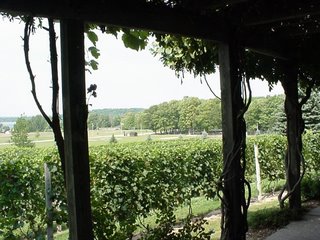
Soon Herb and I will be walking around everyone's favorite summer memory - making place, Mackinaw Island, for the 'Lilac Run'. Hope the weather is good!
After a few days there, it's on to the Mission Peninsula - where we'll be visiting the tasting rooms and 'soaking in the scenery' for a few days. We'll be staying at a B&B for the first time, so I'll report back on that when we get home. Herb doesn't mind camping, but he is reacting oddly to the idea of sharing a bathroom in a B&B. Go figure.
The photo is looking out to Bowers Harbor from Bowers Harbor Vineyard's tasting room early last September.
I clipped this recipe from one of the websites I visited while learning more about Michigan wineries.
MICHIGAN VINEYARDS SALAD- Sandhill Crane Vineyards
Salads are traditionally difficult to pair with wines because of the acidity of the vinaigrette. By substituting some of the vinegar with reduced wine, you are able to soften the acidity and create a special vinaigrette that teams well with the same wine.
Mixed greens
Dried cherries
Sliced pears
Blue cheese, crumbled
Pecans, toasted
Blushing Crane vinaigrette:
½ cup Blushing Crane wine
1 Tbsp Dijon mustard
2 Tbsp white wine vinegar
salt and freshly ground pepper to taste
1 cup olive oil
Reduce wine over medium heat to one-half volume. Whisk together mustard, reduced wine, and vinegar. Season with salt and pepper. Dribble oil into the bowl in a slow, steady stream, whisking constantly, until dressing is creamy and thickened and all the oil has been incorporated. Yield: about 1 ¼ cups
Toss together ingredients and serve immediately.
Sunday, June 04, 2006
Saturday, June 03, 2006
salad days

Springtime Herb and Flower Salad (Scottish, Medieval)
Yield: 6 Servings
(British Measurements)
2 bn Watercress
1 pk Mustard greens & cress
2 oz Fresh parsley sprigs
1 Leek; finely sliced
6 Spring onions; chopped
1 oz Sorrel leaves; chopped
1 oz Dandelion leaves; chopped
1 Fennel bulb; sliced into matchsticks
1 oz Daisy leaves; chopped
Red sage leaves
Mint leaves
1 Fresh rosemary sprig; chopped
1 cl Garlic
1 tb Wine vinegar
Salt & pepper to taste
6 tb Olive oil
Violets, primrose, daisies, blue
borage flowers, dandelions & alexander
buds to decorate
Wash and dry all the salad greens and prepare it.
Mix together in a large bowl, which has been rubbed
well with a garlic clove, reserving the flowers.
Place the wine vinegar, seasonings and olive oil
into a screw-topped jar and shake well to blend.
Pour over the salad just before serving and mix
again carefully.
Decorate with the flowers as you wish and serve
immediately.
Makes about 6 servings.
Historical note:
This is the earliest salad recipe in English.
Mixed herb and flower salads proved so popular
that they continued in fashion through to the
17th century. The salad would change according
to the season and what grew in each cook's herb
garden, so adapt and experiment with the basic
recipe as you wish, as long as the result is
colourful.
** A Book of Historical Recipes **
by Sara Paston-Williams
The National Trust of Scotland, 1995
ISBN = 0-7078-0240-7
ORIGINAL RECIPE:
Salat (dated from 1390 AD)
"Take persel (parsley), sawge, grene garlec,
chibolles (spring onions), oynouns, leek,
borage, myntes, porrettes (a type of leek),
fennel, and town cressis, rew, rosemaye,
purslayne; lave and wasche hem clene.
Pike hem.
Pluk hem small with thyme hande, and mingle
hem wel with rawe oile; lay on vynegar and
salt, and serve it forth."
Friday, June 02, 2006
HOUSE BLESSING

Your house is Love's house.
It is a sanctuary,
a garden,
a safe haven.
May it be delightful.
May it be a home that encourages
creativity and peace,
togetherness and private time.
May it be an environment
that celebrates life,
untidy and ever flowing.
May simplicity be honored in your house,
valuing love above all else.
May your house be a place
where daily chores and small moments
are all approached with reverence and with love.
Where mistakes are seen as lessons learned.
Where kindness, forgiveness, laughter, joy,
and calm enthusiasm
nourish all who enter through its doors.
May all who visit leave refreshed.
May all who live in your house
live in contentment and harmony,
finding nothing lacking,
rejoicing in the way things are.
Good Mother, Welcome.
-- Ingrid Goff-Maidoff
Thursday, June 01, 2006
a little Florist humor
Two old men were sitting on a park bench outside the local town hall when a flower show was in progress.
One leaned over to the other and said, "Cripes! Life is boring, we never have any fun these days. For $5.00 I'd take my clothes off and streak through the flower show!"
"You're on!" said the other old fellow, holding up five dollars.
As fast as he could, the first old man fumbled his way out of his clothes and completely naked, streaked through the front door of the town hall, followed by loud applause.
The streaker burst out through the door surrounded by a cheering crowd.
"Wow, what happened?" asked his friend.
"It was great!" he said, "I won first prize for The Best Dried Arrangement!"
Wednesday, May 31, 2006
the continuing miracle
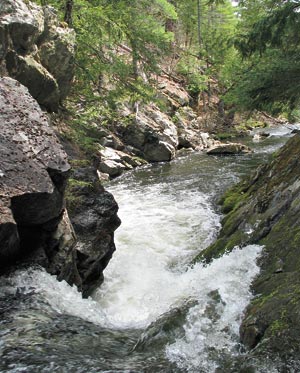
"The miraculous is not extraordinary but the common mode of existence. It is our daily bread. Whoever really has considered the lilies of the field or the birds of the air and pondered the improbability of their existence in this warm world within the cold and empty stellar distances will hardly balk at the turning of water into wine - which was, after all, a very small miracle. We forget the greater and still continuing miracle by which water (with soil and sunlight) is turned into grapes."
-- Wendell Berry
It was said once that we should live with the next seven generations in mind. This is called Mindfulness in other cultures.
If all of creation is sacred, why are we turning away from the stewardship of what we inherited?
The photo is an Upper Peninsula, Michigan stream that is the last home to the unique Coaster Brook Trout. We will over time assuredly pollute this stream with the mining (de)regulations that our fine Michigan legislature have devised, and though neither you or I profit from this mine, our world and our grandchildren's world will be a tiny trout less than what it once was.
Should you care about a trout that you will never see?
Ecology means the 'web of life', that all nature is connected; and the health of the huge system is dependent on health of the tiniest part of it. That trout is part of a stream ecosystem, which is part of the ecosystem of Lake Superior, which is part of the ecosystem of the Great Lakes, and beyond.
What can we do if our leadership is beholden to "other values"?
If you want to see how your legislator votes on environmental issues, check this link to the Michigan League of Conservation Voters. There you will find a downloadable report card with lots of information, and you can decide if it is important to you to be a steward of the earth. You can choose to vote for your seventh generation.
We really don't have anywhere else to go, so why don't we take care of the place we live?
Tuesday, May 30, 2006
Some broccoli !
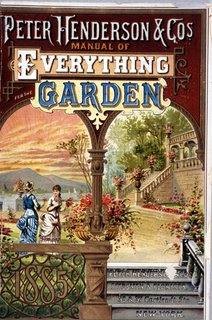
Don't know how far back I copied this little garden-inspired sermonette, or where I found it.
SOME BROCCOLI!
By Jim Rawdon
When we bought our first house, I rototilled a plot and planted a garden. Saturday morning at the farmers' market, I bought various vegetable sets including broccoli, which we really like.
After I placed the vegetables in rows in the ground, I had one broccoli plant left. I put it in at the back of the plot. My garden thrived except for that broccoli at the back. It produced nothing except leaves that curled and wrinkled like a sick plant.
Why? Maybe it needs more fertilizer, water or spray for pests, I thought. But nothing helped.
Then it occurred to me: Perhaps I had it backward. Am I watering fertilizing and spraying too much? So one-by-one I quit watering, fertilizing, weeding and applying pesticides. But the broccoli didn't improve, so I gave up. I had lots else to do - work, kids, chores.
When summer ended, like a good gardener I pulled up dried-up okra stalks and tomato vines. When I'd worked my way to the back of the garden, I saw that broccoli - covered with Brussels sprouts!
Somehow at the farmers' market a Brussels sprout plant got mixed in with the broccoli sets.
All summer long I'd thought something was wrong with the plant at the back of the garden. But those leaves wrinkled and rolled up because that's what Brussels sprouts do.
I'd done everything trying to stop the plant from becoming what it was - Brussels sprouts. I tried to do what only God can do, change its basic nature.
Remembering that "broccoli" makes me wonder: Do I ever make wrong assumption about people or circumstances?
Do I ever try to change individuals or situations from what God intended, instead of trying to be "an instrument for noble purposes, made holy, useful to the Master" (2 Timothy 2:21)?
Do I do the good thing when what's needed is the right thing?
- Jim Rawdon started gardening 50 years ago, helping his grandfather. He is a pastor retired on disability following a cycling accident, he lives and writes in Kansas City, Kansas.
Monday, May 29, 2006
May
journal entry for 1 May 1861, by Henry Wadsworth Longfellow
Sunday, May 28, 2006
Sprouting a 2,000 year old seed

Why did I post this year-old article, even if I just think it's interesting and garden-related?
Because it reminds us that we don't need to plant the WHOLE packet of seeds. Plant as many as you need, and a few to give away, and if you don't trust the germination rate or your luck, then plant a few extra. But then tape the package closed again, and for MOST seeds, you can save them in the back of the fridge to plant again.
I store them in a tightly sealing Tupperware-type box to keep them fresh. I've certainly planted 10-year old basil seeds with success.
This way, you can try something new next year, while still planting your favorite old stand-bys.
June 12, 2005
After 2,000 Years, a Seed From Ancient Judea Sprouts
By STEVEN ERLANGER
New York Times
JERUSALEM, June 11 - Israeli doctors and scientists have succeeded in germinating a date seed nearly 2,000 years old.
The seed, nicknamed Methuselah, was taken from an excavation at Masada, the cliff fortress where, in A.D. 73, 960 Jewish zealots died by their own hand, rather than surrender to a Roman assault. The point is to find out what was so exceptional about the original date palm of Judea, much praised in the Bible and the Koran for its shade, food, beauty and medicinal qualities, but long ago destroyed by the crusaders.
"The righteous shall flourish like the palm tree," says Psalm 92. "They shall still bring forth fruit in old age. They shall be fat and flourishing."
Well, we'll see. Dr. Sarah Sallon, who runs a project on medicinal plants of the Middle East, notes that the date palm in ancient times symbolized the tree of life. But Dr. Elaine Solowey, who germinated the seed and is growing it in quarantine, says plants grown from ancient seeds "usually keel over and die soon," having used most of their nutrients in remaining alive.
The plant is now 11.8 inches tall and has produced seven leaves, one of which was removed for DNA testing. Radiocarbon dating in Switzerland on a snip of the seed showed it to be 1,990 years old, plus or minus 50 years. So the date seed dates from 35 B.C. to A.D. 65, just before the famed Roman siege.
Three date seeds were taken from Level 34 of the Masada dig. They were found in a storeroom, and are presumably from dates eaten by the defenders, Dr. Sallon says.
Mordechai Kislef, director of botanical archeology at Bar-Ilan University, had some date seeds from Ehud Netzer, who excavated Masada in the 1970's. "They were sitting in a drawer, and when I asked for one, he said, 'You're mad,' but finally gave me three," Dr. Sallon said. "Then I gave them to Elaine, who's an expert on arid agriculture and dates." Dr. Solowey said: "Well, I didn't have much hope that any would come up, but you know how Sarah is."
Dr. Sallon, who is a pediatric gastroenterologist trained at University College, London, came to Israel 20 years ago. She is the director of the Louis L. Borick Natural Medicine Research Center at Hadassah Medical Organization, which she set up 10 years ago to study natural products and therapies, from Tibetan and Chinese medicine to the indigenous medicinal plants of the Middle East. The idea is to preserve these plants and their oral histories in a modernizing region, but also to domesticate them, evaluate them scientifically and then try to integrate them into conventional medicine.
Dr. Solowey, who teaches agriculture and sustainable farming at the Arava Institute for Environmental Studies, based at Kibbutz Ketura in the southern Negev, works on finding new crops for arid and saline areas like Jordan, Gaza and Morocco. She also works with Dr. Sallon to domesticate indigenous plants that appear to have medicinal uses.
Dr. Solowey grew up in the San Joaquin Valley in California and studied horticulture, then turned away from commercial agriculture in disgust, coming here in 1971. "I don't come to organic agriculture from the hippie side, but as a frustrated agricultural scientist," she said.
"We've bred for yield and taste, but not hardiness, so we have a lot of plants as hardy as French poodles, so we have to spray to protect them, and then we pay the price," she said. "There isn't a cubic centimeter of water in the San Joaquin Valley that isn't polluted with something."
She planted the date seeds at the end of January after trying to draw them out of their deep dormancy. She first soaked the seeds in hot water to soften the coat, then in an acid rich in hormones, then in an enzymatic fertilizer made of seaweed and other nutrients.
"I've done other recalcitrant seeds," she said. "It wasn't a project with a high priority. I had no idea if the food in the seed was still good, but I put them in new pots in new potting soil and plugged them into drip irrigation and kind of forgot about them."
About six weeks later, she said, "I saw the earth cracked in a pot and much to my astonishment, one of these came up."
The first two leaves looked odd, she said, very flat and pale. "But the third looked like a date leaf with lines, and every one since has looked more and more normal - like it had a hard time getting out of the seed."
Lotus seeds of about 1,200 years of age have been sprouted in China, and after the Nazis bombed London's Natural History Museum in World War II and a lot of water was used to put out the fire, seeds of 500 years of age also germinated.
"But no one had done it from 2,000 years old," Dr. Sallon said.
In the time of Pliny, forests of date palms covered the area from Lake Galilee to the Dead Sea and made Jericho famous; a date palm features on ancient coinage, as it does on the current Israeli 10-shekel coin.
The date palm symbolized ancient Israel; the honey of "the land of milk and honey" came from the date. It is praised as a tonic to increase longevity, as a laxative, as a cure for infections and as an aphrodisiac, Dr. Sallon said. But the dates of Judea were destroyed before the Middle Ages, and what dates Israel grows now were imported in the 1950's and 60's from California and originated elsewhere in the Middle East.
The Prophet Muhammad considered the date of great importance for medicine, food, construction and income, and it is described in the Koran as a "symbol of goodness" associated with heaven.
Dates need to grow 30 years to reach maturity and can live as long as 200 years.
But it is the female date that is considered holy, and that bears fruit. "Men are rather superfluous in the date industry," Dr. Sallon said.
"O.K, I have a date plant," Dr. Solowey said. "If it lives, it will be years before we eat any dates. And that's if it's female. There's a 50-50 chance. And if it's a male, it will just be a curiosity."
Saturday, May 27, 2006
my mother's garden

My mother kept a garden,
a garden of the heart,
she planted all the good things
that gave my life its start.
She turned me to the sunshine
and encouraged me to dream,
fostering and nurturing
the seeds of self-esteem . . .
And when the winds and rain came,
she protected me enough,
but not too much because she knew
I'd need to stand up strong and tough.
Her constant good example
always taught me right from wrong--
markers for my pathway
that will last a lifetime long.
I am my Mother's garden.
I am her legacy-
and I hope today she feels the love
reflected back from me.
~anonymous
Friday, May 26, 2006
Look closely
"A flower is relatively small. Everyone has many associations with a flower - the idea of flowers. You put out your hand to touch the flowers - lean forward to smell it - maybe touch it with your lips almost without thinking - or give it to someone to please them. Still - in a way - nobody sees a flower - really - it is so small - we haven't time - and to see takes time like to have a friend takes time. If I could paint the flower exactly as I see it no one would see what I see because I would paint it small like the flower is small.
So I said to myself - I'll paint what I see - what the flower is to me but I'll paint it big and they will be surprised into taking time to look at it."
-- About Myself, by Georgia O'Keeffe, 1939
Thursday, May 25, 2006
Primavera
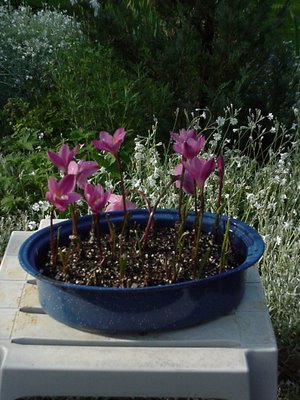
This old blue enamel roasting pan is planted with Zephyr Lilies. Going on three years now, all they ask is to be brought into frost free storage for dormancy in the winter. I got the idea for the roasting pan from some book about old fashioned plants, but someone else will have to remind me of the source, as it has slipped my mind. They are also called Fairy Lilies, or Summer Crocuses, and incidentally, the leaves will appear after the flowers.
They seem to bloom off and on all summer, most often after a good soaking. I haven't even felt bad about not repotting them, they 'll get that attention if they begin to flag. Or, I'll replace them...they are cheap and plentiful in the common rack-packages at Meijers.
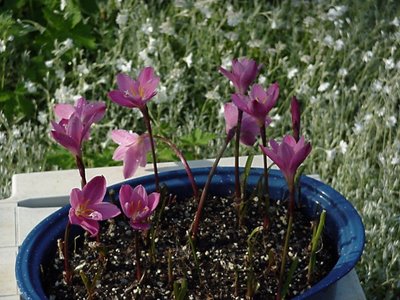
Anyway, my Zephyr lilies bloomed today, so I Googled 'Zephyr' for us all.
Zephyr, as you will remember from my Floralia story about Flora, was the Roman god of the gentle west wind who brought spring. You'll notice in a lot of the portrayals of Zephyr, he is shown with insect-type wings. That may be the fairy connection with Zephyr.
I can't copy this Victorian Rococo picture of "The Triumph of Zephyr and Flora" so you'll have to click on the link to see it: but do, it's sweet.
Anyway, my reading on Wikipedia led me to an Italian Renaissance painting called Sandro Botticelli's 'The Primavera' (1482), which means The Arrival of Spring. (In case you don't know, you can click on the photo to see it in its full size.)
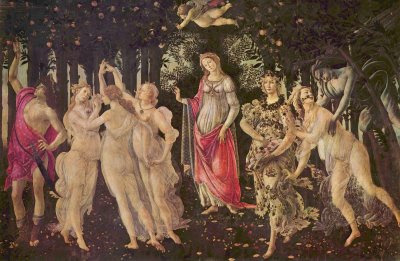
You'll notice it is along the lines of the birth of Venus picture in the Floralia story, and the story procedes along with the art...
One source for this scene is Ovid's Fasti, a poetic calendar describing Roman festivals.
For the month of May, Flora tells how she was once the nymph Chloris, and breathes out flowers as she does so.
Aroused to a fiery passion by her beauty, Zephyr, the god of the wind, follows her and forcefully takes her as his wife. Regretting his violence, he transforms her into Flora, his gift gives her a beautiful garden in which eternal spring reigns.
Botticelli is depicting two separate moments in Ovid's narrative, the erotic pursuit of Chloris by Zephyr and her subsequent transformation into Flora. This is why the clothes of the two women, who also do not appear to notice each other, are being blown in different directions.
Flora is standing next to Venus and scattering roses, the flowers of the goddess of love. In his philosophical didactic poem De Rerum Natura the classical writer Lucretius celebrated both goddesses in a single spring scene. As the passage also contains other figures in Botticelli's group, it is probably one of the main sources for the painting.
"Spring-time and Venus come,
And Venus' boy, the winged harbinger, steps on before,
And hard on Zephyr's foot-prints Mother Flora,
Sprinkling the ways before them, filleth all
With colours and with odours excellent."
The statue of Flora and Zephyr is by a French Rococo Victorian artist, Clodion.

